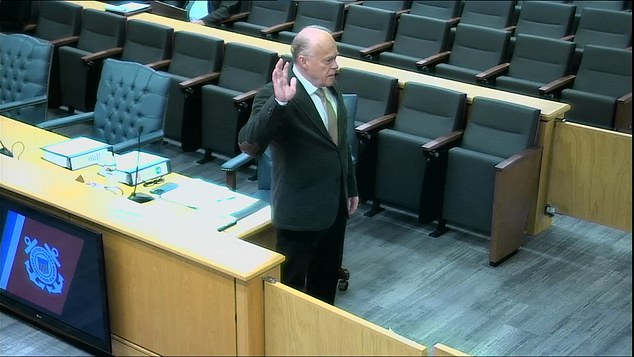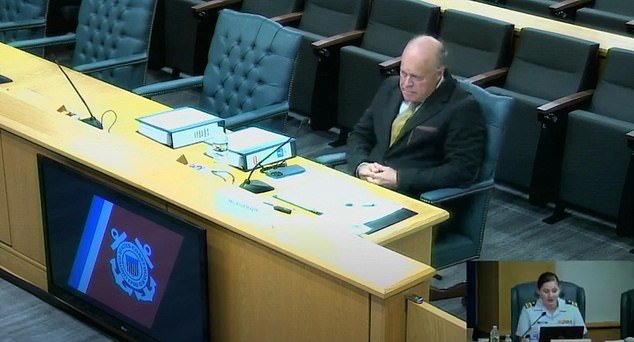An OceanGate passenger who went aboard the Titan submersible two years before it imploded last year said today that his mission was aborted due to an apparent mechanical failure that caused the vessel to ‘spin around in circles’.
A U.S. Coast Guard investigatory panel has listened to four days of testimony that raised questions about the company’s operations before the doomed mission.
Fred Hagen was first to testify Friday and was identified as a ‘mission specialist,’ which he and other witnesses have characterized as people who paid a fee to play a role in OceanGate’s underwater exploration.
He said his 2021 mission to the Titanic was aborted when the Titan began malfunctioning and it was clear they were not going to reach the fabled wreck site.
The Titan appeared to be off course on its way to the Titanic, so the crew decided to use thrusters so the submersible could make its way to the wreck, Hagen said, but noted how the starboard thruster failed to activate.



‘We realized that all it could do was spin around in circles, making right turns,’ Hagen said. ‘At this juncture, we obviously weren’t going to be able to navigate to the Titanic.’
Hagen said the Titan dropped weights, resurfaced and the mission was scrapped. He said he was aware of the potentially unsafe nature of getting in the experimental submersible.
‘Anyone that wanted to go was either delusional if they didn’t think that it was dangerous, or they were embracing the risk,’ he said.
OceanGate co-founder and Titan pilot Stockton Rush was among five people who died when the submersible imploded en route to the site of the Titanic wreck in June 2023.
Earlier this month, the Coast Guard opened a public hearing that is part of a high-level investigation into the cause of the implosion. The public hearing began on September 16 and some of the testimony has focused on problems the Washington state company had prior to the fatal 2023 dive.



During Thursday’s testimony, company scientific director Steven Ross told the investigators the sub experienced a malfunction just days before the Titanic dive. Earlier in the week, former OceanGate operations director David Lochridge said he frequently clashed with Rush and felt the company was committed only to making money.
‘The whole idea behind the company was to make money,’ Lochridge testified. ‘There was very little in the way of science.’
Meanwhile, another former OceanGate mission specialist, Renata Rojas, broke down in tears yesterday before recounting her agonising wait for the doomed Titan submersible to resurface.
She described her role in helping the launch last June and said that all on board understood the risks involved in their dive deep beneath the Atlantic Ocean.
This was never sold as a Disney ride,’ she said. ‘It was an expedition that … things happen and you have to adapt to change.’
Ms Rojas was on board the Polar Prince icebreaker on the surface when the Titan lost contact on June 18 last year.
She said one of their final reports was: ‘All good here’.
But the witness became emotional and began to cry when recalling how the submersible then stopped sending updates.



A chilling 3D reconstruction of the Titan’s final journey was released by the US Coast Guard, depicting its final movements, after new footage of the wreckage on the seabed was also revealed, taken days after the tragedy unfolded.
The hearing is expected to resume next week and run through to September 27.
Other witnesses Friday included engineer Dave Dyer of the University of Washington Applied Physics Lab. Dyer provided details about the lab’s relationship with OceanGate while its submersible was in development.
‘The intent was to provide engineering expertise to OceanGate,’ Dyer said.
Lochridge and other witnesses have painted a picture of a company led by people who were impatient to get the unconventionally designed craft into the water. Lochridge said he filed a complaint with the federal Occupational Safety and Health Administration about the company. OSHA ‘promptly referred his safety allegations regarding the Titan submersible to the Coast Guard,’ a spokesperson for the agency said Thursday.
The deadly accident set off a worldwide debate about the future of private undersea exploration. Coast Guard officials noted at the start of the hearing that the submersible had not been independently reviewed, as is standard practice. That and Titan’s unusual design subjected it to scrutiny in the undersea exploration community.
But Renata Rojas, a mission specialist for the company, told the Coast Guard the firm was staffed by competent people who wanted to ‘make dreams come true.’ Rojas’ testimony struck a different tone than some of the earlier witnesses.
‘I was learning a lot and working with amazing people,’ Rojas said. ‘Some of those people are very hardworking individuals that were just trying to make dreams come true.’

OceanGate suspended its operations after the implosion. The company has no full-time employees currently, but has been represented by an attorney during the hearing.
During the submersible’s final dive on June 18, 2023, the crew lost contact after an exchange of texts about the Titan’s depth and weight as it descended. The support ship Polar Prince then sent repeated messages asking if the Titan could still see the ship on its onboard display.
One of the last messages from Titan’s crew to Polar Prince before the submersible imploded stated, ‘all good here,’ according to a visual recreation presented earlier in the hearing.
When the submersible was reported missing, rescuers rushed ships, planes and other equipment to an area about 435 miles (700 kilometers) south of St. John’s, Newfoundland. Four days later, wreckage of the Titan was found on the ocean floor about 330 yards (300 meters) off the bow of the Titanic, Coast Guard officials said. No one on board survived.
OceanGate said it has been fully cooperating with the Coast Guard and NTSB investigations since they began. The Titan had been making voyages to the Titanic wreckage site going back to 2021.
